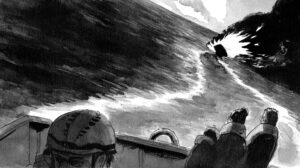By land or by sea:
Will Chile open the door to deep sea mining?
Written by: Paula Díaz Levi
Illustrations by: Juan Carlos Hernández
As a country with both a booming mining industry and an enormous Exclusive Economic Zone (EEZ) in the ocean, Chile makes the ideal case-study to examine the future of terrestrial mining, and the temptation to exploit the seabed. Is Deep Sea Mining the solution for the problems of land-mining, or a threat to an industry that pays “Chile’s salary?”
No one knows his real name, but we do know that he was a man who entered a small gallery dug into the rock to extract atacamite, a mineral that would probably end up smelted to become axes, chisels or ornaments. While striking the rock, around the year 550, the roof of the gallery collapsed, claiming the life of the unfortunate miner.
Time moved forward until 1899, when his mummified body was found in Chuquicamata, later baptized as the “Copper Man” due to the slow infiltration of the red metal that dyed his skin green. After being sold and exhibited, he ended up in New York, far from the Atacama Desert where he was born, and where communities have practiced mining since pre-Hispanic times.
Even so, at the end of the 19th century, close to the discovery of the Copper Man, the mining protagonist was not copper, but saltpeter, whose control was one of the triggers of the War of the Pacific that pitted Chile against Peru and Bolivia between 1879 and 1884. For this reason, the historian, anthropologist and researcher at the Catholic University of the North, Damir Galaz-Mandakovic, points out that the Atacama Desert that we see today is “a territory that is the result of a mining war.”
"Everything that has happened in Atacama has not been decided in Chile, it has been decided in London, in Hamburg, in Manhattan, where the headquarters of the large economic groups that have redefined the desert are located."
Damir Galaz-Mandakovic, historian
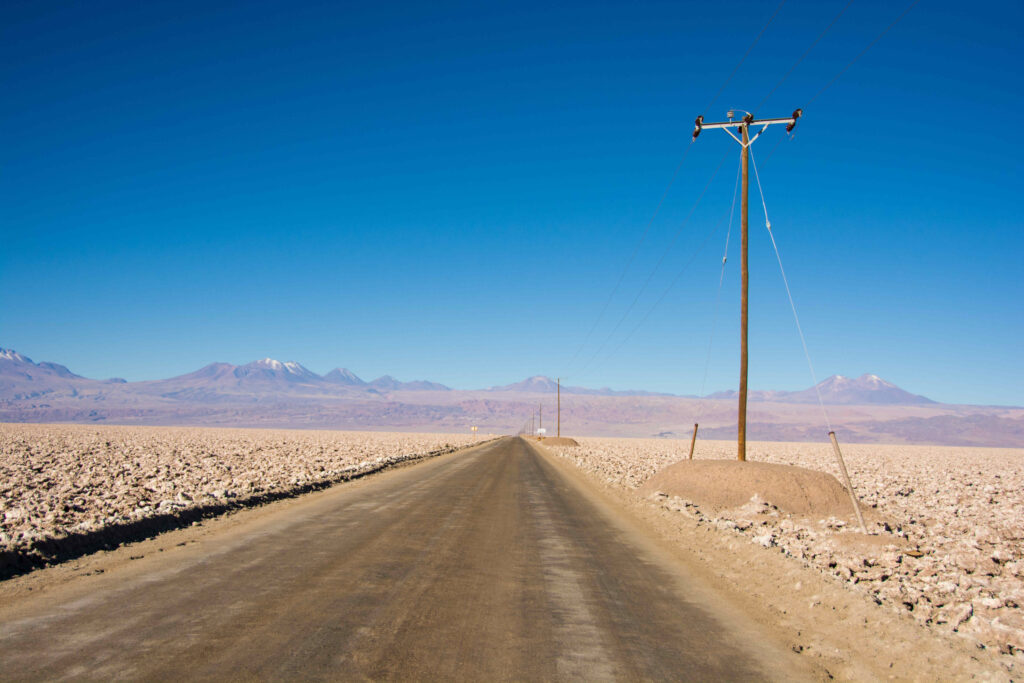
Thus, mining has marked the history of a country that today is the main copper producer in the world. The economic importance of the red metal is such that for a long time it has been called “Chile’s salary“.
That brings us to the current moment, where land-mining faces a possible competitor in Deep Sea Mining. The Chilean case is interesting if we consider that it is a mining country that is also oceanic, with a huge marine area that in the future could be in the sights of those seeking to exploit the seabed.
Regarding the long-term impact of land-based mining, opinions are mixed. “With a historical look, one could say that thanks to mining in some cases there has been a structural or infrastructural development. For example, the discovery of silver in the Copiapó sector allowed Chile to have its first railroad,” says José Cabello, a geologist with more than 20 years of experience in mining, and who today is president of the Center for the Study of Strategic and Critical Minerals in Chile (CEMEC).
However, there have also been costs. Cabello recognizes that “the country has a debt as well, that is, there is no direct correlation between the economic value of production and that it is reflected in the country, because unfortunately one of the characteristics of Chile continues to be inequality”.
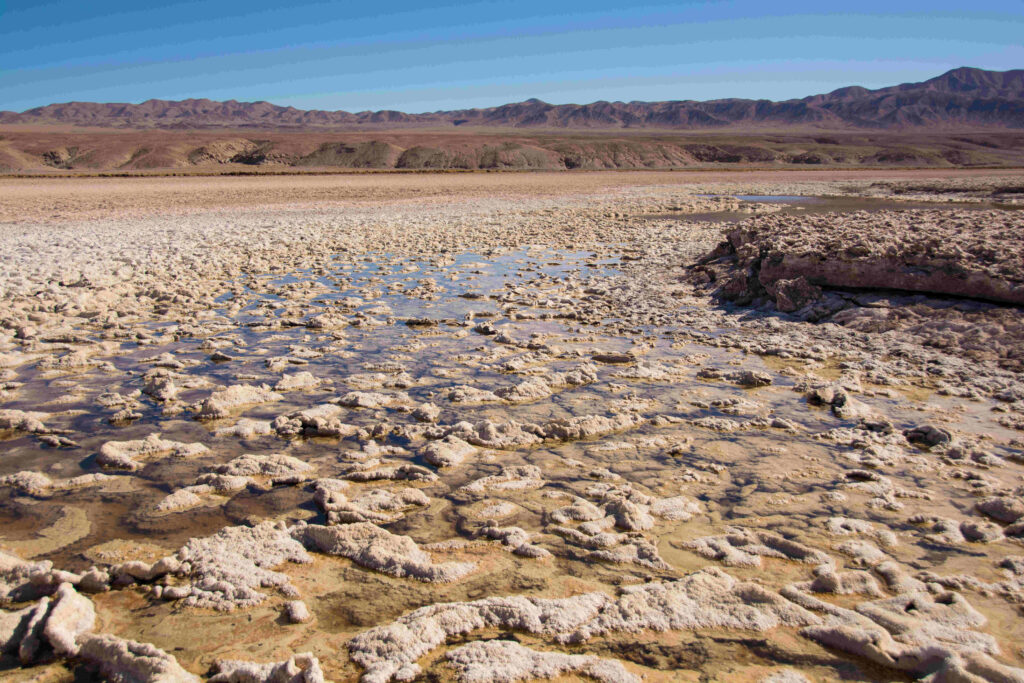
In fact, mining has also generated significant downsides, such as health effects, displacement of communities, loss of biodiversity, water depletion and contamination, and air pollution. For example, in some places, emissions of sulfur dioxide, nitrogen oxides, as well as arsenic, lead and other pollutants have been associated with respiratory and cardiovascular diseases and cancer, affecting different sectors of the population, including children and indigenous communities.
For this reason Vladimir Reyes, president of the indigenous organization Council of Atacameño Peoples, assures that, “more than benefits, they are costs, because there is a lot of environmental damage. That is why the Council of Peoples, through the 18 communities, is always oriented towards the protection of the Great Atacama Salt Flat”.
The Atacama Salt Flat has garnered attention for its substantial reserves of lithium, a critical mineral whose demand has increased worldwide for the manufacture of electronics, electric vehicles and renewable energy devices. According to a recent report by the International Energy Agency, the energy sector was the main factor that tripled the global demand for lithium between 2017 and 2022.
The problem is that the effects of mining have been felt. Indeed, there is an ongoing environmental reparation lawsuit filed by the State Defense Council against Minera Escondida, Compañía Minera Zaldívar and Albemarle “for the continuous and illegal extraction of water resources” from the Monturaqui-Negrillar-Tilopozo aquifer, which feeds the Atacama Salt Flat, causing “irreparable damage” to the ecosystem “that will not recover before the year 2200”.
Regarding the state of the Atacama Salt Flat, Reyes comments that "the amount of water it contained" has decreased, as have the flamingos that once flocked in this area. Other ecosystems, such as meadows and lagoons, have also been depleted. "And the native trees, such as the carob tree. This is one of the great damages caused by massive extraction, mainly of lithium," he laments.
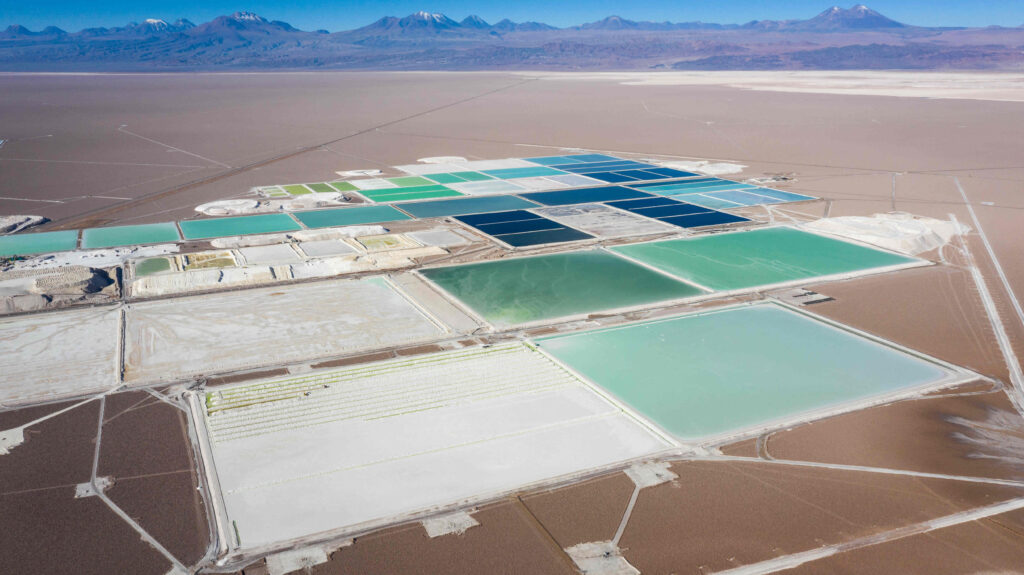
In recent times, the mining industry has promoted different measures, such as the integration of renewable energies in its processes, as well as the use of desalinated water to replace, in part, the demand for water reserves in the desert. “There is a very accelerated change in the energy matrix and the incorporation of the use of seawater in mining processes,” says Norman Toro, director of FIA Research and Innovation at Arturo Prat University.
But, for Galaz-Mandakovic, “there is a maritime extractivism that is being installed with desalination plants,” although that is not the only reason why some are looking to the sea.
Deep sea mining, a debate far from over
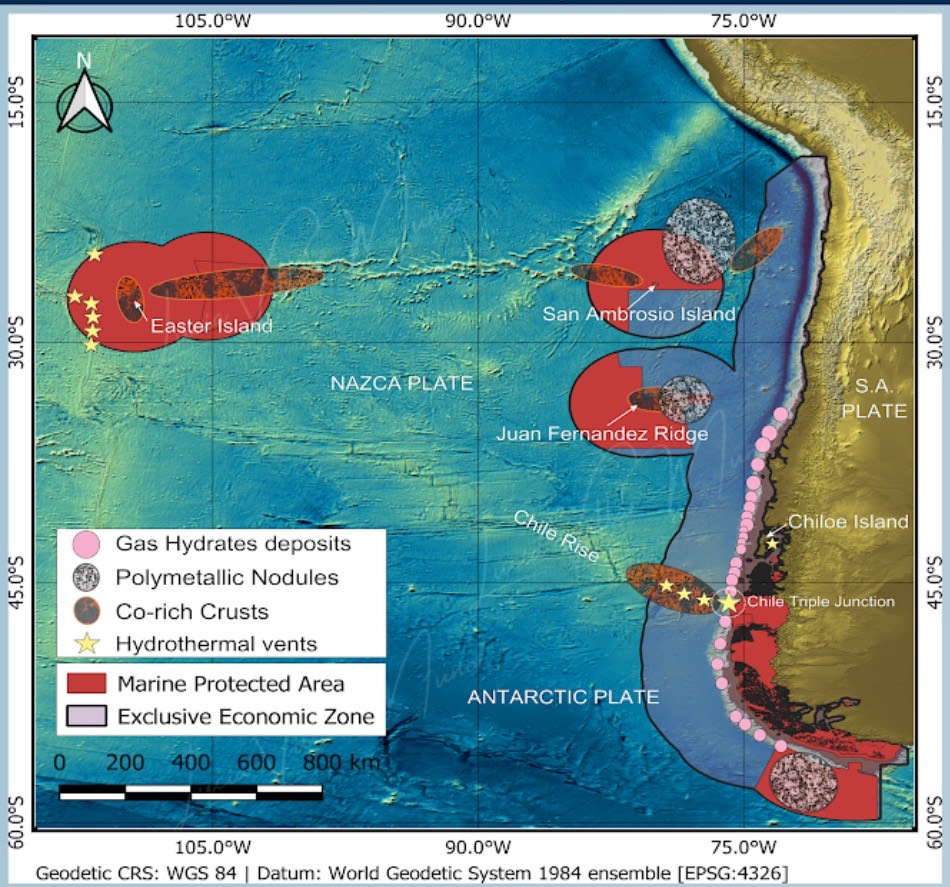
There were high expectations for the International Seabed Authority (ISA) Council and Assembly meetings, which took place in Jamaica during July, to regulate deep sea mining in international waters. In the end, the ISA adopted a roadmap for regulation by 2025, while the Chilean government has actively pushed for a precautionary pause in this activity.
In any case, one wonders whether – in the future – underwater mining will find a home in a mining and oceanic country like Chile, whose Exclusive Economic Zone around the coast is almost five times the size of the continental land area.
“We must be guided by what the science says, and so far the first results seem to favor underwater mining if we compare it with land mining in terms of lower CO2 emissions, less destruction of territory, less water consumption in extraction, less water pollution, zero pollution in cities, etc.,” says Lucía Villar-Muñoz, oceanographer and postdoctoral researcher in the Department of Geophysics at the University of Chile.
For the researcher, the results of the environmental impact assessments that are being carried out in international waters must be awaited, “making deep sea mining the first extractive industry in history that is being regulated before extraction has even begun. This is a huge environmental achievement and shows that they want to do things right from the start in this nascent industry.”
Among the potential impacts of deep sea mining are water use and discharge, water quality (due to hydraulic or fuel leaks), noise and vibrations, and sedimentation of waste material.
"Several current studies point to the low environmental impact that future submarine mining of polymetallic nodules, which is the most studied, would produce compared to land-based mining," says the oceanographer, who adds that extracting these rocks from the seabed "is equivalent to harvesting potatoes on land, since the polymetallic nodules are found on the surface, which makes this type of mining much less invasive and destructive than any mining project on land."
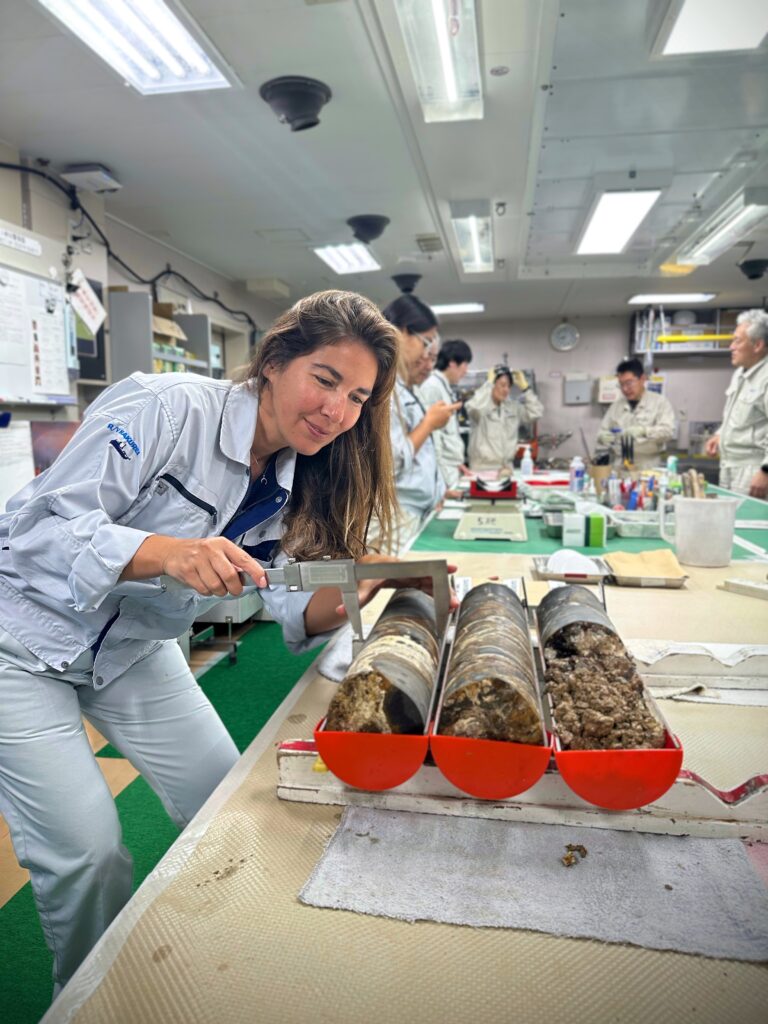
On the contrary, she warns that mining cobalt-rich crusts or oceanic massive sulfides “should not be allowed,” based on current data, as they would generate far greater damage to the environment than polymetallic nodule mining.
A study recently published in Current Biology shows that the first successful test of deep sea cobalt mining had variable effects on a seamount in Japan, including a decrease in fish density, and the removal of some of the fauna both in and around the mine site.
And if there is someone who knows about seamounts, it is Javier Sellanes, full professor at the Faculty of Marine Sciences of the Catholic University of the North. The scientist points out that “it will depend on where you exert this impact. Perhaps coastal communities are naturally exposed to more frequent environmental disturbances than deep sea communities, which are used to greater environmental stability.”
In short, “it is very difficult to reduce in a few words what the impacts could be, because you have to look at them case by case”.
Concerns persist, because just as with land-based mining, where air pollution spreads through the air, deep sea mining within an Exclusive Economic Zone could generate sediment plumes that drift into international waters, affecting an area that, in the words of the United Nations Convention on the Law of the Sea, is “the common heritage of [hu]mankind”.
Potential areas for deep sea mining in Chile
Although no special legislation has been established for deep sea mining in Chile, there are existing instruments that could regulate it. The first is the 1980 Constitution, drafted during the dictatorship of Augusto Pinochet. The Constitution states that minerals within the territorial sea are not concessionable, so they can only be exploited by the State or one of its companies, or by a private company, through a special operating contract. Then, Law 18,097 on Mining Concessions establishes the exception that minerals under the sea are concessionable when they can be reached by a tunnel from the mainland. Finally, the Mining Code reiterates all of the above.
In addition, the National Geology and Mining Service (Sernageomin) has a Marine Geology Plan that seeks to generate geological information on the ocean floor, island territories and Antarctica. According to its official website, within its first stage it contemplates the elaboration of geological maps of the islands of Juan Fernández and Rapa Nui. However, after repeated requests for interviews and a request via the Transparency Law, it was not possible to access detailed and updated information. Through Transparency, the institution pointed out that “this National Service has not carried out evaluation studies on the places with the greatest potential for the development of submarine mining in Chile”.
However, although knowledge about mineral deposits in Chile is scarce and scattered, the most significant non-energy mineral resources correspond to ferromanganese nodules and crusts found in abyssal plains and seamounts, as well as phosphorite deposits, gold and titanium placers and massive sulfides.
This is reflected in different works, such as a publication in the scientific journal Andean Geology and the “Chile Polimetálico” project, which was co-financed by the Chilean Economic Development Agency (Corfo), the Chilean Copper Commission (Cochilco) and the Alta Ley Corporation, with the aim of contributing to a more diversified mining industry that goes “beyond copper”.
In fact, potential resources and areas for deep sea mining exploration have been identified for years.
Starting in northern Chile in a sector bordering the oceanic flank of the trench, at the latitude of the mouth of the Loa River in the Tarapacá Region; the continental margin near the Mejillones Peninsula in the Antofagasta Region; and the Caldera basin in the Atacama Region. If we go to the south of the country, in addition to artisanal gold mining on beaches, manganese nodules have been sampled – further down the coast – in the Magallanes Region.
An interesting case is that of the Valparaíso Region with its biodiversity emblems. We are referring to the areas of Rapa Nui (aka Easter Island), the Juan Fernández Archipelago, and the volcanic cordon of which the Salas y Gómez and San Félix and San Ambrosio islands are part. Each of these islands contain marine protected areas.
“By logic, no type of industry should be allowed in these sectors, since they were designated as such mainly because of their great biological and ecological value,” Villar points out.
In addition, Sellanes underlines that the biodiversity of the latter areas is “unique” and “with levels of marine endemism among the highest in the world”.
Is there interest in deep sea mining in Chile?
Deep sea mining has appeared from time to time in opinion columns, talks, and seminars. Even the Chilean Mining Chamber, an institution made up of businessmen and professionals in the area, has a Submarine Mining Commission, although it was not possible to arrange an interview for details.
When asked about the feasibility of deep sea mining in Chile, one person who is quite skeptical and critical is Cabello. “At this moment it doesn’t make sense. First of all, Chile has very good mineral resources [on land] and we still need to make it more sustainable. On the other hand, the marine environment is very delicate and neither do we have in Chile any resource that one could say is superior to what we have in the continental area.”
Similar is the position of Sergio Hernández, who was vice-president of Cochilco and former member of the delegation to the International Seabed Authority. Today, as executive director of the Industrial Mining Suppliers Association (Aprimin), he states, “Chile does not have the capacities to develop this mining nor is there much interest due to its high terrestrial potential, but we do know that there are relatively interesting concentrations of copper and manganese in the waters of the Exclusive Economic Zone.”
"It is likely to happen in the very long term, but we believe that humanity today does not have sufficient technologies to be able to ensure any damage to marine biodiversity. Our interest is, to put it very bluntly, in protecting terrestrial mining production".
Sergio Hernández, Executive Director of Aprimin
For Toro, who spoke on this subject at the end of August at the Tarapacá International Mining Congress, he does believe that deep sea mining is necessary to advance towards the energy transition and in the face of “the scarcity of critical raw materials”. “There is a lot of talk about the manufacture of batteries in Chile or other types of products, as if we have a comparative advantage for having lithium, but it is forgotten that lithium is just another part of the battery, not to say 5%. So, more cobalt than lithium is needed in Chile (…) and cobalt is very abundant in submarine mineral resources. So, other niches could be opened,” he points out.
However, with respect to the aforementioned scarcity of minerals on land, Cabello, the president of CEMEC, assures that “exploration is not exhausted in Chile. If we refer to copper and lithium, at this moment, with the exploration carried out, we have resources for more than 100 years.”
A threat to “Chile’s salary”?
Although the sources consulted in the mining sector assure that there is no interest in the industry, there are some actors that have been following the international discussions on deep sea mining, especially due to Chile’s status as the world’s main copper producer. This is the case of Cochilco, a technical agency that advises the Chilean government and protects the interests of the State.
In fact, in 2017 Cochilco published the report “Submarine mining: challenges, constraints and opportunities”. Through a Transparency Law request, Unbias The News accessed the document that synthesized the available information and the implications for the copper market. It calculated that copper from submarine mines would represent 0.38% of the total supply by 2025, considering at that time the existence of the Solwara 1 project in Papua New Guinea, so that, “it is not expected to threaten Chile’s participation in the world copper supply.”
Even so, when referring to a seminar held on the subject, it is mentioned that “deep sea mining is important for Chile, not only because it is one of the largest copper producers in the world, but also because of the economic, environmental and legal implications that this could have.”
In addition, a minute drafted in 2022 by Cochilco, also delivered via the Transparency Law, provides estimates on the exploitation of polymetallic nodules between 2032 and 2037, with a view to the Nauru requirement that was discussed a few weeks ago in Jamaica. Thus it predicts that, if deep sea mining contracts start production in 2029, “there would be no impact until this date and in the next 8 years, i.e. until 2037 the impact would be minimal on the copper market given the low production volumes associated even with the maximum scenario (12 contractors)”. Therefore, he establishes that the effects on tax revenues in Chile would be marginal, at least for 15 to 20 years.
Benefit for a few?
“The deep ocean plays a very important role in sequestering the excess carbon that we are emitting into the atmosphere. So, by disturbing these sites, it is not clear how this capacity of the ocean could be altered,” Sellanes remarks, alluding to the climate crisis that some seek to mitigate with seabed minerals.
While many advocate for a moratorium, others claim that underwater mining could be an alternative to the problems and challenges on land. “Something very logical that underwater mining presents is the great social advantage, since no one lives in those deep waters and therefore no community would be affected, as happens in most cases with land mining,” argues Villar.
However, the lack of research and evidence on its effects is still a stumbling block for an activity that could become a reality, in the future, in national and international waters.
The concern of some lies not only in the impact on the health of the ocean, but also in the fact that the vices of terrestrial mining could be repeated, as witnessed in the Atacama Desert, with its riches and misfortunes. For Sellanes, underwater mining “would continue to increase global inequalities because only a handful of countries in the world have the technology to carry out this type of exploitation. Probably China, Japan, the United States, France, Germany and other countries are the ones that could have the technology to mine in the deep ocean. It is something that would continue to increase the asymmetries that exist between developed and developing countries. Benefit for a few, but impact for all.” ~
Salar de Atacama, Chile
Stay tuned for the next parts in our series, where we will delve into the business side of deep sea mining and the question of how best to protect our oceans
Read our articles
“
Full fathom five thy father lies;
Of his bones are coral made;
Those are pearls that were his eyes:
Nothing of him that doth fade,
But doth suffer a sea-change
Into something rich and strange.
William Shakespeare, The Tempest

This article is part of our series “Chain reactions – How the green revolution can reshape sustainable development”. The series is funded by the European Journalism Centre, through the Solutions Journalism Accelerator. The Solutions Journalism Accelerator is supported by the Bill & Melinda Gates Foundation.






